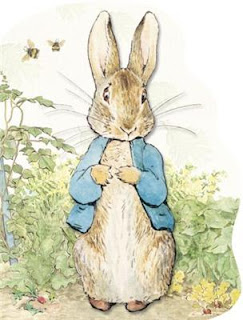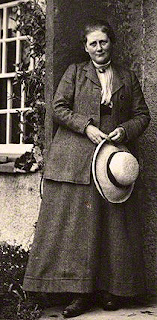1. Peter Rabbit
Peter Rabbit is a fictional animal character in various children's stories by Beatrix Potter.[1] He first appeared in The Tale of Peter Rabbit in 1902 and subsequently in five more books between 1904 and 1912. Spinoff merchandise includes dishes, wallpaper, and dolls. He appears as a character in a number of adaptations.
Peter Rabbit made his first appearance in 1902 in The Tale of Peter Rabbit. Peter disobeys his mother's orders and sneaks into Mr. McGregor's garden, eating as many vegetables as he can before Mr. McGregor spots him and chases him about. Peter manages to escape, but not before losing his jacket and shoes, which Mr. McGregor uses to dress a scarecrow. Peter returns home weary and ill and is put to bed with a dose of chamomile tea.
In The Tale of Benjamin Bunny, first published in 1904, Peter's cousin Benjamin Bunny brings him back to Mr. McGregor's garden and they retrieve the clothes Peter lost in The Tale of Peter Rabbit. But after they gather onions to give to Peter's mother, they are captured by Mr. McGregor's cat. Benjamin's father arrives and rescues them, but also reprimands Peter and Benjamin for going into the garden by whipping them with a switch. In this tale, Peter displays some trepidation about returning to the garden.
In The Tale of The Flopsy Bunnies, first published in 1909, Peter has a small role and appears only briefly. He is grown up and his sister Flopsy is now married to his cousin Benjamin Bunny. The two are the parents of six little Flopsy Bunnies. Peter and his mother keep a nursery garden and the bunnies come by asking him for spare cabbage.
In The Tale of Mr. Tod, first published in 1912, Benjamin and Flopsy's children are kidnapped by notorious badger Tommy Brock. Peter helps Benjamin chase after Brock, who hides out in the house of the fox Mr. Tod. Mr. Tod finds Brock sleeping in his bed and as the two get into a scuffle, Peter and Benjamin rescue the children.
Peter makes cameo appearances in two other tales. In The Tale of Mrs. Tiggy-Winkle, first published in 1905, Peter and Benjamin are customers of Mrs. Tiggy-Winkle, a hedgehog washerwoman. The two rabbits are depicted in one illustration peeping from the forest foliage. In The Tale of Ginger and Pickles, first published in 1909, Peter and other characters from Potter's previous stories make cameo appearances in the artwork patronising the shop of Ginger and Pickles.
To mark the 110th anniversary of the publication of The Tale of Peter Rabbit, Frederick Warne & Co. commissioned British actress Emma Thompson to write The Further Tale of Peter Rabbit, in which Peter ends up in Scotland after accidentally hitching a ride on Mr. and Mrs. McGregor's wagon. The book was released on 18 September 2012.
On 27 September 2012, it was announced that Emma Thompson would write two more Peter Rabbit books, with the first released in Christmas 2013 and the second sometime in 2014.
2. Beatrix Potter
Helen Beatrix Potter (28 July 1866 – 22 December 1943) was an English writer, illustrator, natural scientist, and conservationist best known for her children's books featuring animals, such as those in The Tale of Peter Rabbit.
Born into a privileged household, Potter was educated by governesses and grew up isolated from other children. She had numerous pets and spent holidays in Scotland and the Lake District, developing a love of landscape, flora and fauna, all of which she closely observed and painted.
Though Potter was typical of women of her generation in having limited opportunities for higher education, her study and watercolors of fungi led to her being widely respected in the field of mycology. In her thirties, Potter published the highly successful children's book, The Tale of Peter Rabbit. Potter began writing and illustrating children's books full-time.
With the proceeds from the books and a legacy from an aunt, in 1905 Potter bought Hill Top Farm in Near Sawrey, a village in the Lake District, which at that time was in Lancashire. Over the following decades, she purchased additional farms to preserve the unique hill country landscape. In 1913, at the age of 47, she married William Heelis, a respected local solicitor from Hawkshead. Potter was also a prize-winning breeder of Herdwick sheep and a prosperous farmer keenly interested in land preservation. She continued to write and illustrate, and to design spin-off merchandise based on her children's books for British publisher Warne, until the duties of land management and her diminishing eyesight made it difficult to continue.
Potter wrote about 30 books; the best known being her 24 children's tales. She died of pneumonia and heart disease on 22 December 1943 at her home in Near Sawrey at age 77, leaving almost all her property to the National Trust. She is credited with preserving much of the land that now constitutes the Lake District National Park. Potter's books continue to sell throughout the world in many languages with her stories being retold in song, film, ballet, and animation, and her life depicted in a feature film and television film.
3. Chamomile
Chamomile or camomile is the common name for several daisy-like plants of the family Asteraceae that are commonly used to make herb infusions to serve various medicinal purposes. Popular uses of chamomile preparations include treating hay fever, inflammation, muscle spasms, menstrual disorders, insomnia, ulcers, gastrointestinal disorders, and haemorrhoids. Camomile tea is also used to treat skin conditions such as eczema, chickenpox and psoriasis.
4. Virgil
Publius Vergilius Maro , was an ancient Roman poet of the Augustan period. He is known for three acclaimed works of Latin literature, the Eclogues (or Bucolics), the Georgics, and the epic Aeneid. A number of minor poems, collected in the Appendix Vergiliana, are sometimes attributed to him.
Virgil is traditionally ranked as one of Rome's greatest poets. His Aeneid has been considered the national epic of ancient Rome from the time of its composition to the present day. Modeled after Homer's Iliad and Odyssey, the Aeneid follows the Trojan refugee Aeneas as he struggles to fulfill his destiny and arrive on the shores of Italy—in Roman mythology the founding act of Rome. Virgil's work has had wide and deep influence on Western literature, most notably Dante's Divine Comedy, in which Virgil appears as Dante's guide through hell and purgatory.





沒有留言:
張貼留言